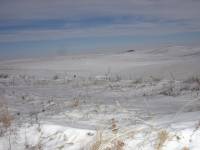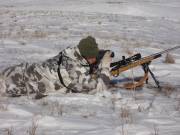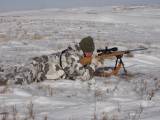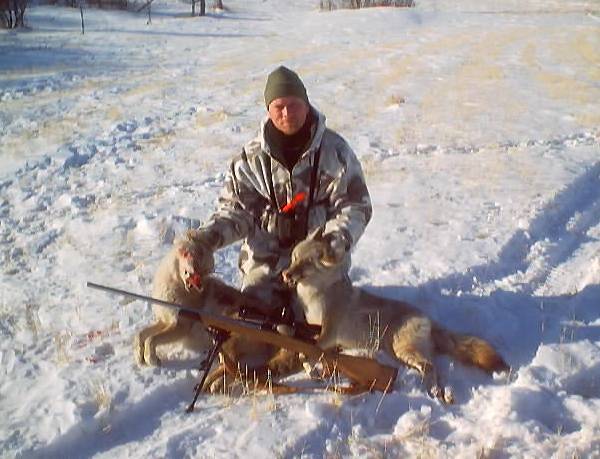Hunting the prairie winds
 It?s Thursday night and I am packing up for an early Saturday morning hunt (of course I am packing Thursday night so I can get some sleep Friday night). I call my hunting partner Jayson Deziel of Artistic wildlife Taxidermy several times that night going over everything twice. The third time his wife answers the phone you can tell she is starting to think I am out of my mind. Friday, work drags on like a North Dakota winter and I can?t believe a 10-hour day seems like a whole damn week. Friday night comes around and I can?t sleep, I just toss and turn and watch the clock. Finally at 3:30 am the alarm goes off and it is time to get going. Jayson gets to my house at 4:00 am and we are off and running. We have a three-hour drive to get to our first calling area.
It?s Thursday night and I am packing up for an early Saturday morning hunt (of course I am packing Thursday night so I can get some sleep Friday night). I call my hunting partner Jayson Deziel of Artistic wildlife Taxidermy several times that night going over everything twice. The third time his wife answers the phone you can tell she is starting to think I am out of my mind. Friday, work drags on like a North Dakota winter and I can?t believe a 10-hour day seems like a whole damn week. Friday night comes around and I can?t sleep, I just toss and turn and watch the clock. Finally at 3:30 am the alarm goes off and it is time to get going. Jayson gets to my house at 4:00 am and we are off and running. We have a three-hour drive to get to our first calling area. Well, this is going to be hard to believe but its 6:40 am and we?re there (we might have been speeding a little bit) and its blowing like there is a hurricane coming. North Dakota and wind go hand in hand- if its blowing less than 15 miles an hour, you are usually at work on a Wednesday with no chance at all of getting out. So, now what? Go home? Not a chance.
 Spotting and stalking can be effective on days like this. I have found that if you start thinking about what a coyote would be doing on a completely horrible day like this, it would make sense that given the choice any sane animal or man would be home in bed. A sleeping coyote is usely a dead coyote if you see him before he sees you. I have found coyotes sound asleep in the middle of stubble fields but when it starts to really blow, I try to look for big wooded draws that would offer some protection from the wind.
Spotting and stalking can be effective on days like this. I have found that if you start thinking about what a coyote would be doing on a completely horrible day like this, it would make sense that given the choice any sane animal or man would be home in bed. A sleeping coyote is usely a dead coyote if you see him before he sees you. I have found coyotes sound asleep in the middle of stubble fields but when it starts to really blow, I try to look for big wooded draws that would offer some protection from the wind. Coyote?s thoughts are usually not too far from food. Keep this in mind when you are looking for these little dogs. Coyotes want to know what is going on with their food source 24/7. They do this with their eyes, ears and nose. You will tend to find coyotes down wind of the herd, be it cows, sheep, or deer. When I am out looking for coyotes on a less than perfect day, I first find cattle and sheep ranches. Then I talk to the rancher and find out where he has been seeing coyotes and ask if he can show me the area around his winter-feed lot or spring calving barn. Look down wind of this food source. Start about a mile or so down wind and look for anything that could hold a coyote. Start marking some structure that looks promising and decide what would be the best set-up for each spot. The wind will dictate how close you will need to be at each stand. Realize that if you are going to call coyotes you better plan on lacing up your boots doing some walking. Nothing will ruin a well thought- out plan faster than having a coyote spot your vehicle. Start down wind and move towards your first calling spot. I like to glass the area I am going to call before moving into it. You should always expect to see coyotes- after all, that?s why you picked this spot to begin with, right? Remember to hunt into each stand because you never know what is around the next corner. Stay low and keep your head up, always watching for movement. Use your binoculars to scan every inch of terrain in hopes of catching a coyote on the move, or, better yet, find one bedded down. When you try spotting coyotes, just remember to look for things that look out of place. One way to do this is with a good pair of optics-and I do mean good. Inexpensive good optics do not exist. I spend a lot of time looking at odd shaped rocks. At a mile, coyotes don?t always look like coyotes.
Call your first stand. If you have a lot of wind, get in close to the structure you are calling to. Remember that you will probably only call each set up for 10 ? 15 minutes. In heavy wind if they are going to hear you they will be fairly close. After going through your calling sequence, start walking to your next stand, always moving towards the cattle or whatever you have determined to be the food source in your area.
 If you do catch a coyote sleeping and you are in full whites, stalking a bedded coyote can be very intense. Expect some close action. Coyotes do not sit still for long but at times you can find them curled up in a ball out of the wind taking a snooze in the middle of the afternoon. Pay close attention to the South side of hills during midday when you can catch a coyote sunning himself. If you watch them they will look up often and even get up to stretch. They may walk in a small circle just like the family dog before lying down again. When they do put their head down, you will have the opportunity to move in closer. Set up and try calling them in, but don?t be afraid of going in and shooting them right in their bed. Coyotes will not always come to a call no matter who is blowing on it or what tape you are using. Just because he doesn?t jump up and come tearing in there doesn?t mean you are doing something wrong. Sometimes they just have other things on their mind. If you have one bedded down out there and he looks like he is going to stay put, get the wind in your face, move slow, keep the noise down and you?ll be surprised at how close you can get.
If you do catch a coyote sleeping and you are in full whites, stalking a bedded coyote can be very intense. Expect some close action. Coyotes do not sit still for long but at times you can find them curled up in a ball out of the wind taking a snooze in the middle of the afternoon. Pay close attention to the South side of hills during midday when you can catch a coyote sunning himself. If you watch them they will look up often and even get up to stretch. They may walk in a small circle just like the family dog before lying down again. When they do put their head down, you will have the opportunity to move in closer. Set up and try calling them in, but don?t be afraid of going in and shooting them right in their bed. Coyotes will not always come to a call no matter who is blowing on it or what tape you are using. Just because he doesn?t jump up and come tearing in there doesn?t mean you are doing something wrong. Sometimes they just have other things on their mind. If you have one bedded down out there and he looks like he is going to stay put, get the wind in your face, move slow, keep the noise down and you?ll be surprised at how close you can get.As you are working a pasture, I have found it hard calling close to livestock- especially horses. They get pretty wild when you start calling and will usually come running to see what?s going on. This is typically not good, so try to keep this in mind as you are picking a spot to call from. At times I have had cattle get aggressive to a call, but for the most part, they will not bother you. My father and I had been working a pasture when we came across a small herd with four coyotes moving among the cattle. The rancher was unaware of the day-old calf that was more than a little early. The coyotes had been trying to push that calf away from the herd. One of the coyotes spotted us coming around the corner and he headed out. The other three did not see us, but they followed after the first one.
 Make sure you hunt from stand to stand and don?t get too caught up in just getting to the next spot to call. When you get up towards the livestock, feed lot, haystacks or calving barn, set up and call this area like you would any other terrain. Talk with ranchers and they will tell you that they see coyotes in with the livestock, and sleeping in the hay bales.
Make sure you hunt from stand to stand and don?t get too caught up in just getting to the next spot to call. When you get up towards the livestock, feed lot, haystacks or calving barn, set up and call this area like you would any other terrain. Talk with ranchers and they will tell you that they see coyotes in with the livestock, and sleeping in the hay bales. There are no guarantees in life, and there are certainly none in hunting. Unfortunately, I am unable to get out and hunt coyotes as much as I would like. That?s why I have learned to make the best of even the worst days. Spotting and stalking coyotes can be another tactic you can put in your bag of tricks for hunting coyotes.